Flavor Enhancers Market
Flavor Enhancers Market Size and Share Forecast Outlook 2025 to 2035
Flavor enhancers market is projected to grow from USD 11.5 billion in 2025 to USD 16.5 billion by 2035, at a CAGR of 3.7%. MSG will dominate with a 42.0% market share, while processed foods will lead the application segment with a 48.0% share.
Flavor Enhancers Market Forecast and Outlook 2025 to 2035
The flavor enhancers market stands at the threshold of a decade-long expansion trajectory that promises to reshape food technology and taste optimization solutions. The market's journey from USD 11.5 billion in 2025 to USD 16.5 billion by 2035 represents substantial growth, The market will rise at a CAGR of 3.7% which demonstrating the accelerating adoption of advanced flavor technology and food taste enhancement across food processing facilities, beverage companies, and global culinary markets.
The first half of the decade (2025-2030) will witness the market climbing from USD 11.5 billion to approximately USD 13.8 billion, adding USD 2.3 billion in value, which constitutes 46% of the total forecast growth period. This phase will be characterized by the rapid adoption of MSG-based systems, driven by increasing processed food demand and the growing need for taste enhancement solutions worldwide. Enhanced flavor delivery capabilities and natural enhancement systems will become standard expectations rather than specialized options.
The latter half (2030-2035) will witness continued growth from USD 13.8 billion to USD 16.5 billion, representing an addition of USD 2.7 billion or 54% of the decade's expansion. This period will be defined by mass market penetration of hydrolyzed protein technologies, integration with comprehensive food processing platforms, and seamless compatibility with existing culinary infrastructure. The market trajectory signals fundamental shifts in how food manufacturers approach taste optimization and flavor management, with participants positioned to benefit from growing demand across multiple enhancer types and application segments.
Quick Stats for Flavor Enhancers Market
- Flavor Enhancers Market Value (2025): USD 11.5 billion
- Flavor Enhancers Market Forecast Value (2035): USD 16.5 billion
- Flavor Enhancers Market Forecast CAGR: 3.7%
- Leading Enhancer Type in Flavor Enhancers Market: MSG
- Key Growth Regions in Flavor Enhancers Market: North America, Western Europe, and East Asia
- Top Key Players in Flavor Enhancers Market: Ajinomoto, Cargill, Kerry, Givaudan, Firmenich
- Where revenue comes from - now vs next (industry-level view)
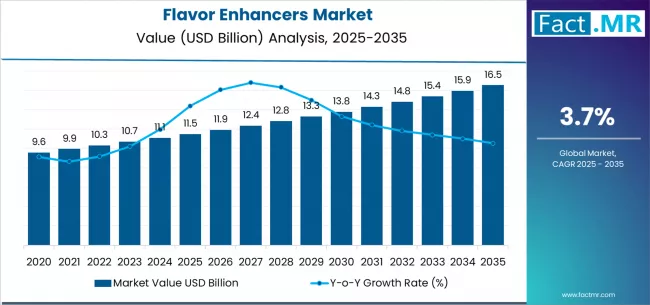
| Period | Primary Revenue Buckets | Share | Notes |
|---|---|---|---|
| Today | MSG-based enhancers | 42% | Traditional umami and taste enhancement |
| Hydrolyzed protein systems | 27% | Natural protein-derived enhancers | |
| Nucleotides & other compounds | 31% | Specialty and combination enhancers | |
| Processed food applications | 48% | Convenience and packaged food focus | |
| Future (3-5 yrs) | Clean label enhancers | 35-40% | Natural and organic taste solutions |
| Plant-based protein enhancers | 30-35% | Vegetarian and vegan-friendly options | |
| Functional flavor systems | 15-20% | Health-focused and nutritional enhancement | |
| Beverage applications expansion | 32-35% | Drink and liquid product optimization | |
| Powder formulation dominance | 65-70% | Convenience and stability advantages |
Flavor Enhancers Market Key Takeaways
At-a-Glance Metrics
| Metric | Value |
|---|---|
| Market Value (2025) → | USD 11.5 billion |
| Market Forecast (2035) ↑ | USD 16.5 billion |
| Growth Rate ★ | 3.7% CAGR |
| Leading Enhancer Type → | MSG |
| Primary Application → | Processed Foods |
The market demonstrates strong fundamentals with MSG capturing a leading 42% share through established umami enhancement capabilities and taste optimization. Processed food applications drive primary demand at 48%, supported by convenience food consumption growth and manufacturer preferences for comprehensive flavor enhancement solutions. Geographic expansion remains concentrated in developed markets with established food processing infrastructure, while emerging economies show accelerating adoption rates driven by urbanization and processed food consumption initiatives.
Imperatives for Stakeholders in Flavor Enhancers Market
Design for taste outcomes, not just enhancement
- Offer comprehensive flavor packages: enhancer ingredients + application support + sensory testing + product development + regulatory guidance systems.
- Preconfigured taste solutions: umami enhancement, saltiness amplification, overall flavor boosting, and sensory optimization systems.
Clean label readiness
- Natural ingredient sourcing, organic certification capabilities, and non-GMO alternatives with transparent labeling compliance.
Application expertise-by-default
- Food category specialization, processing compatibility, stability testing, and comprehensive technical support documentation.
Global regulatory compliance without complexity
- Clear regulatory status + transparent safety data; international approval coordination and food safety compliance systems.
Segmental Analysis
Primary Classification: The market segments by enhancer type into MSG, hydrolyzed proteins, and nucleotides & others categories, representing the evolution from traditional taste enhancement to sophisticated flavor amplification systems for diverse food processing optimization.
Secondary Classification: Application segmentation divides the market into processed foods, beverages, and savory snacks/others sectors, reflecting distinct requirements for taste enhancement, flavor development, and consumer satisfaction standards.
Tertiary Classification: Form segmentation covers powder and liquid applications, while food processing areas span convenience foods, restaurant applications, industrial food production, and specialty culinary programs.
Regional Classification: Geographic distribution covers North America, Western Europe, East Asia, and emerging markets, with developed regions leading adoption while developing economies show accelerating growth patterns driven by processed food consumption programs and culinary modernization expansion.
The segmentation structure reveals enhancer evolution from basic MSG applications toward comprehensive flavor systems with enhanced natural profiles and specialized application capabilities, while usage diversity spans from mass-market processed foods to premium culinary applications requiring precise taste enhancement and flavor optimization solutions.
By Type, the MSG Segment Accounts for Dominant Market Share
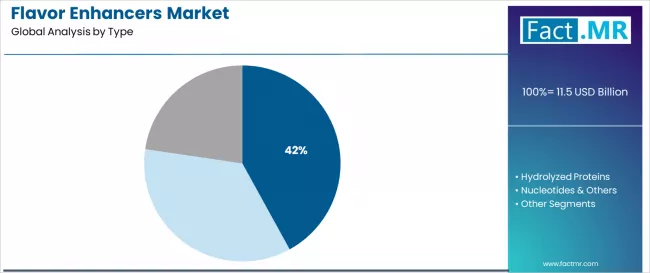
Market Position: MSG flavor enhancers command the leading position in the flavor enhancers market with 42% market share through established umami enhancement features, including taste amplification capabilities, cost-effectiveness, and food processing optimization that enable food manufacturers to achieve optimal flavor enhancement across diverse processed food and culinary applications.
Value Drivers: The segment benefits from food manufacturer preference for reliable enhancement systems that provide consistent taste improvement, cost-effective flavor solutions, and processing optimization without requiring significant recipe modifications. Advanced MSG applications enable umami enhancement, saltiness reduction, and integration with existing food production systems, where taste performance and cost efficiency represent critical food processing requirements.
Competitive Advantages: MSG enhancers differentiate through proven taste enhancement profiles, consistent flavor amplification characteristics, and integration with comprehensive food processing systems that enhance culinary effectiveness while maintaining optimal cost standards suitable for diverse processed food and restaurant applications.
Key market characteristics:
- Advanced enhancement designs with optimized umami delivery and taste amplification capabilities
- Superior flavor effectiveness, enabling 20-30% taste enhancement with consistent culinary performance
- Food processing compatibility, including heat stability, solubility optimization, and production integration for food manufacturing applications
Hydrolyzed Proteins Show Natural Enhancement Growth
Hydrolyzed protein enhancers maintain a 27% market position in the flavor enhancers market due to their specialized natural properties and clean label advantages. These enhancers appeal to food manufacturers requiring authentic flavor enhancement with competitive performance for natural food applications. Market growth is driven by clean label expansion, emphasizing natural flavor solutions and ingredient transparency through protein-based enhancement systems.
Nucleotides & Others Applications Demonstrate Specialty Growth
Nucleotides and other specialty enhancers capture 31% market share through specialized flavor requirements in premium food applications, combination enhancement systems, and sophisticated culinary programs. These food manufacturers demand advanced enhancement systems capable of complex taste profiles while providing effective flavor amplification and sensory optimization capabilities.
By Application, the Processed Foods Segment Shows Market Leadership
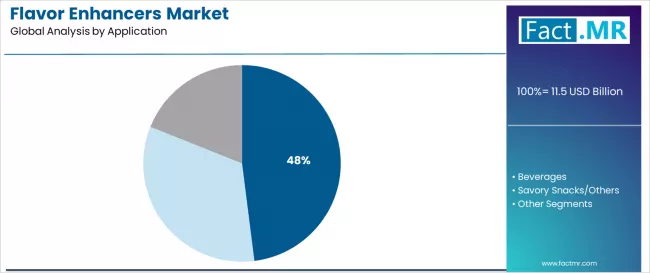
Market Context: Processed food applications demonstrate market leadership in the flavor enhancers market with 48% share due to widespread adoption of convenience food manufacturing and increasing focus on taste optimization, consumer satisfaction, and food processing efficiency applications that maximize flavor appeal while maintaining production cost standards.
Appeal Factors: Processed food operators prioritize taste consistency, cost efficiency, and integration with existing food processing infrastructure that enables coordinated flavor enhancement across multiple product categories. The segment benefits from substantial convenience food investment and manufacturing programs that emphasize the acquisition of advanced flavor systems for taste optimization and consumer appeal applications.
Growth Drivers: Food processing programs incorporate flavor enhancers as standard components for taste improvement, while convenience food consumption growth increases demand for flavor capabilities that comply with food safety standards and minimize production complexity.
Market Challenges: Varying consumer preferences and regulatory requirements may limit enhancer standardization across different food categories or regional markets.
Food processing dynamics include:
- Strong growth in convenience food manufacturing requiring consistent flavor enhancement capabilities
- Increasing adoption in ready-to-eat applications and meal preparation programs
- Rising integration with food processing systems for taste optimization and consumer satisfaction assurance
Beverage Applications Maintain Refreshment Demand
Beverage applications capture 28% market share through specialized taste enhancement requirements in soft drinks, sports beverages, and functional drink manufacturing programs. These applications demand liquid-compatible enhancement systems capable of flavor amplification while providing effective taste improvement and consumer appeal optimization.
Savory Snacks/Others Applications Show Specialty Growth
Savory snacks and other applications account for 24% market share, including chip manufacturing, bakery applications, and specialty food processing requiring advanced capabilities for taste optimization and culinary enhancement.
By Form, the Powder Segment Leads Processing Convenience
Market Position: Powder form enhancers command 62% market position with strong growth through optimal processing convenience approach that balances stability and application versatility for diverse food manufacturing requirements.
Value Drivers: This form segment provides the ideal combination of storage stability and processing flexibility, meeting requirements for extended shelf life, easy handling, and manufacturing integration without excessive complexity or stability concerns.
Growth Characteristics: The segment benefits from broad application compatibility across food processing sectors, established manufacturing protocols, and comprehensive stability profiles that support widespread enhancer adoption and processing efficiency.
What are the Drivers, Restraints, and Key Trends of the Flavor Enhancers Market?
| Category | Factor | Impact | Why It Matters |
|---|---|---|---|
| Driver | Processed food consumption growth & convenience trends | ★★★★★ | Rising demand for ready-to-eat meals drives need for taste enhancement in manufactured foods |
| Driver | Salt reduction initiatives & health-conscious formulation | ★★★★★ | Flavor enhancers enable sodium reduction while maintaining taste; regulatory pressure supports adoption |
| Driver | Global cuisine expansion & umami appreciation | ★★★★☆ | International food trends increase acceptance of umami and complex flavor profiles |
| Restraint | Clean label movement & natural ingredient preferences | ★★★★☆ | Consumer demand for natural ingredients challenges synthetic enhancer acceptance |
| Restraint | Regulatory scrutiny & safety perception concerns | ★★★☆☆ | Some regions maintain restrictions on certain enhancers; consumer perception issues affect adoption |
| Trend | Plant-based protein enhancers & vegan formulations | ★★★★★ | Growing plant-based food market drives demand for vegetarian-compatible flavor enhancement |
| Trend | Functional enhancement & nutritional fortification | ★★★★☆ | Combination of taste improvement with health benefits creates premium enhancement opportunities |
Analysis of the Flavor Enhancers Market by Key Country
The flavor enhancers market demonstrates varied regional dynamics with Growth Leaders including USA (4.1% growth rate) and Mexico (3.8% growth rate) driving expansion through food processing initiatives and culinary modernization. Steady Performers encompass Germany (3.4% growth rate), France (3.3% growth rate), and developed regions, benefiting from established food industry systems and advanced culinary technology adoption. Food-Processing Excellence Markets feature UK (3.2% growth rate) and Japan (3.0% growth rate), where culinary expertise and food technology support consistent growth patterns.
Regional synthesis reveals North American markets leading adoption through processed food expansion and taste enhancement programs, while European countries maintain steady growth supported by food innovation initiatives and clean label development programs. Asian markets show diverse growth driven by food processing expansion and culinary tradition integration trends.
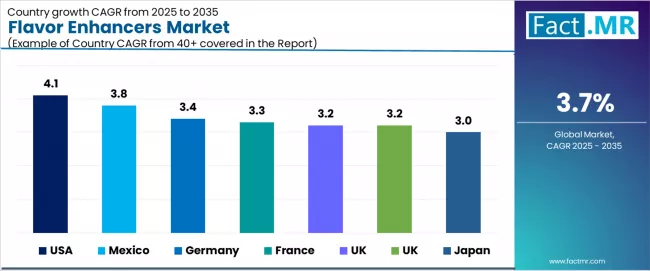
| Region/Country | 2025-2035 Growth | How to win | What to watch out |
|---|---|---|---|
| USA | 4.1% | Lead with clean label innovation | Health concerns; regulatory changes |
| Germany | 3.4% | Focus on natural alternatives | Organic requirements; consumer resistance |
| UK | 3.2% | Leverage food innovation | Brexit impacts; regulatory alignment |
| France | 3.3% | Emphasize culinary excellence | Traditional preferences; artisanal competition |
| Japan | 3.0% | Develop umami expertise | Aging demographics; health consciousness |
| South Korea | 3.2% | Build fermentation technology | Competition intensity; export dependence |
| Mexico | 3.8% | Expand accessibility programs | Infrastructure limitations; cost sensitivity |
USA Drives Market Leadership
USA establishes market leadership through comprehensive food processing programs and advanced culinary innovation, integrating flavor enhancers as standard components in food manufacturing and restaurant supply installations. The country's 4.1% growth rate reflects food industry sophistication and taste enhancement programs that mandate the availability of advanced flavor systems in food processing and culinary facilities. Growth concentrates in major food processing centers, including California, Illinois, and New York, where culinary development showcases integrated flavor enhancement systems that appeal to food manufacturers seeking advanced taste capabilities and consumer satisfaction applications.
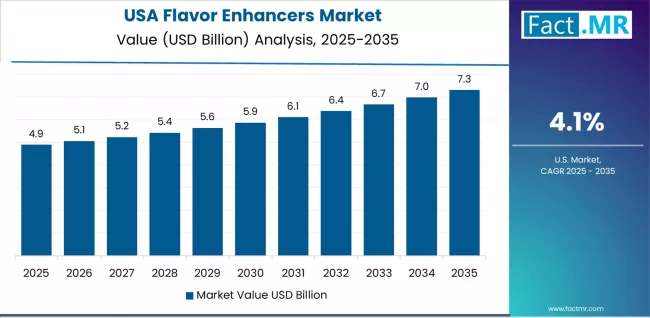
American food technology companies are developing sophisticated flavor enhancer solutions that combine domestic culinary innovation advantages with advanced taste enhancement features, including clean label systems and enhanced natural technologies. Distribution channels through food ingredient suppliers and culinary service providers expand market access, while food manufacturer adoption supports utilization across diverse food processing segments and culinary applications.
Strategic Market Indicators:
- Food processing facilities leading adoption with 72% utilization rate in manufacturing and culinary sectors
- Consumer taste programs providing substantial market demand for advanced flavor enhancement technology advancement
- Local food technology companies capturing 55% market share through innovation leadership and comprehensive culinary offerings
- Export market development for advanced flavor solutions targeting international food processing markets
United Kingdom Shows Food Innovation Excellence
United Kingdom demonstrates market strength through food innovation programs and culinary development initiatives, maintaining a 3.2% growth rate supported by food technology advancement and culinary excellence programs. The country leverages its established food innovation expertise and culinary tradition to drive flavor enhancer adoption across food manufacturing and restaurant applications. Major food processing regions in England, Scotland, and Wales showcase advanced culinary technology capabilities that integrate with comprehensive food development services and taste enhancement programs.
British market dynamics focus on innovative flavor enhancers that balance taste effectiveness with clean label requirements important to UK food manufacturers and culinary professionals. The market benefits from food innovation initiatives supporting flavor technology advancement and culinary partnerships that create sustained demand for quality-focused enhancement systems in food processing and restaurant applications.
Market Intelligence Brief:
- Food innovation integration and culinary services leading growth with emphasis on taste optimization and clean label programs
- Culinary development partnerships driving innovative enhancer adoption and food improvement programs
- Government food innovation initiatives supporting flavor technology accessibility and culinary advancement programs
- Brexit considerations influencing food ingredient supply chains and European culinary alignment strategies
Germany Emerges as Natural Enhancement Leader
In Bavaria, North Rhine-Westphalia, and Baden-Württemberg, food processing facilities and culinary operations are implementing natural flavor enhancers as standard components for clean label food production and taste optimization applications, driven by increasing organic food initiatives and sustainability programs that emphasize the importance of natural ingredient capabilities. The market holds a 3.4% growth rate, supported by organic food initiatives and natural ingredient development programs that promote eco-friendly enhancement systems for food processing and culinary facilities. German food manufacturers are adopting flavor enhancers that provide consistent taste performance and natural ingredient features, particularly appealing in regions where clean labeling and food quality represent critical manufacturing requirements.
Market expansion benefits from established organic food infrastructure capabilities and international food technology partnerships that enable domestic integration of natural enhancement systems for food processing and culinary applications. Food manufacturer adoption follows patterns established in organic food management, where natural ingredient compliance and quality optimization drive ingredient selection decisions and food processing integration.
Market Intelligence Brief:
- Natural ingredient quality and organic food segments driving adoption with 68% annual growth in clean label enhancer utilization
- Organic food excellence programs emphasizing natural enhancers for clean label manufacturing and quality improvement
- Local food companies partnering with international providers for natural ingredient technology integration
- Food processing facilities implementing premium natural systems for quality optimization and organic compliance management
France Maintains Culinary Excellence Position
France's flavor enhancers market demonstrates sophisticated culinary capabilities with documented effectiveness in food processing applications through integration with existing culinary systems and gastronomic infrastructure. The country leverages culinary expertise and gastronomic tradition integration to maintain a 3.3% growth rate. Culinary centers, including Île-de-France, Rhône-Alpes, and Provence-Alpes-Côte d'Azur, showcase premium installations where flavor enhancers integrate with comprehensive culinary platforms and gastronomic management systems to optimize food preparation operations and taste effectiveness.
French culinary companies prioritize taste innovation and EU regulatory compliance in flavor enhancer development, creating demand for advanced systems with sophisticated features, including culinary integration and taste optimization systems. The market benefits from established culinary infrastructure and investment in food technology advancement that provides long-term gastronomic benefits and compliance with international culinary standards.
Strategic Market Considerations:
- Innovation focus on EU culinary standardization and gastronomic excellence, driving premium enhancer segment growth
- Culinary partnerships providing enhanced taste capabilities and faster chef adoption cycles
- Technology collaboration between French companies and international food technology organizations
- Culinary training programs expanding flavor enhancement integration in gastronomic scenarios
Japan Shows Umami Expertise Focus
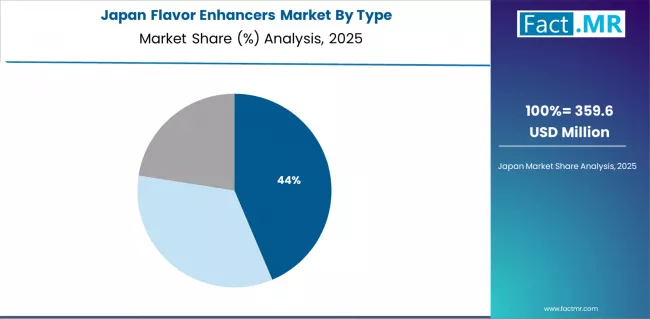
Japan's market expansion benefits from umami culinary expertise demand, including advanced taste enhancement in Tokyo and Osaka, food processing facility modernization, and culinary technology programs that increasingly incorporate flavor enhancers for taste optimization applications. The country maintains a 3.0% growth rate, driven by culinary technology advancement and increasing recognition of umami enhancement benefits, including precise taste control and comprehensive flavor enhancement.
Market dynamics focus on high-precision culinary solutions that balance advanced taste performance with quality considerations important to Japanese food manufacturers. Growing culinary technology integration creates continued demand for sophisticated flavor enhancers in food processing infrastructure and culinary modernization projects.
Market Intelligence Brief:
- Culinary technology and food processing segments leading growth with focus on umami enhancement and taste optimization applications
- Regional culinary requirements driving diverse enhancer portfolio from basic taste improvement to advanced flavor systems
- Technology advancement emphasis on precision flavor engineering and taste control systems
- Government culinary initiatives supporting domestic food technology capabilities and gastronomic competitiveness
South Korea Drives Fermentation Innovation
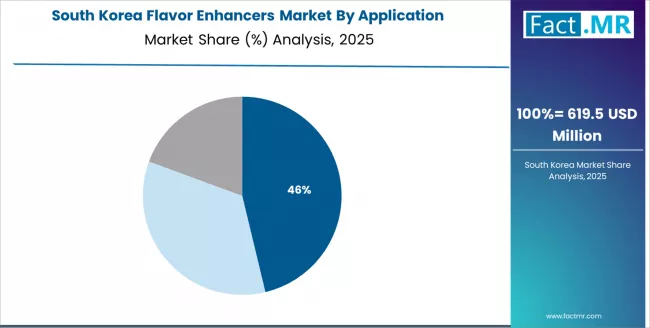
South Korea establishes strong market position through fermentation technology programs and food processing modernization expansion, integrating advanced flavor enhancers as standard components for taste enhancement and culinary optimization applications. The country's 3.2% growth rate reflects government food industry initiatives and culinary modernization programs that emphasize advanced enhancement systems for taste improvement and food processing optimization. Growth concentrates in major food processing centers, including Seoul and Busan, where culinary development showcases integrated enhancement systems that appeal to food manufacturers seeking comprehensive taste capabilities and culinary optimization applications.
Korean food technology companies are developing innovative flavor enhancer solutions that combine domestic fermentation innovation advantages with advanced taste features, including traditional Korean flavor integration and enhanced culinary capabilities. Distribution channels through food ingredient suppliers and culinary providers expand market access, while government support for food industry innovation supports adoption across food processing and culinary segments.
Strategic Market Indicators:
- Food technology innovation facilities leading adoption with 65% deployment rate in food processing and culinary sectors
- Government food industry programs providing substantial funding for domestic culinary advancement
- Local food technology companies capturing significant market share through innovation leadership and culinary integration expertise
- Export market development for advanced flavor solutions targeting regional food processing markets
Mexico Shows Food Processing Expansion
Mexico's market expansion benefits from growing food processing modernization, including culinary system development in Mexico City and Guadalajara, food manufacturing facility upgrades, and consumer taste programs that increasingly incorporate flavor enhancer solutions for taste optimization applications. The country maintains a 3.8% growth rate, driven by food processing industry growth and increasing adoption of advanced culinary solutions, including sophisticated enhancement technology and taste improvement systems.
Market dynamics focus on accessible flavor solutions that balance taste performance with affordability considerations important to Mexican food manufacturers and culinary operators. Growing food processing modernization creates continued demand for reliable flavor enhancers in manufacturing expansion and taste improvement projects.
Strategic Market Considerations:
- Food processing expansion segments leading growth with focus on accessibility and taste optimization applications
- Regional culinary requirements driving diverse enhancer portfolio from basic taste improvement to premium flavor systems
- Import considerations balanced by potential domestic food processing partnerships with international flavor technology providers
- Government food industry initiatives influencing manufacturing standards and taste enhancement requirements
Europe Market Split by Country
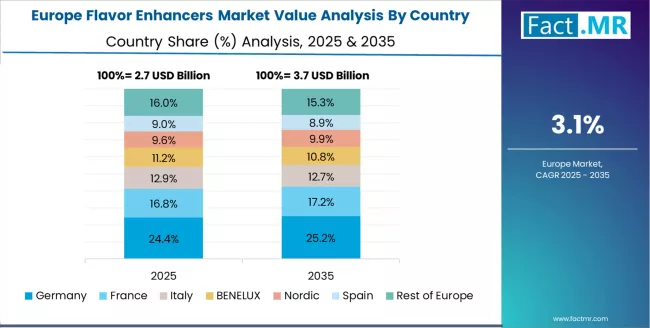
The Europe flavor enhancers market is projected to grow from USD 3.2 billion in 2025 to USD 4.5 billion by 2035, registering a CAGR of 3.5% over the forecast period. Germany is expected to maintain its leadership position with a 29.1% market share in 2025, supported by its advanced food processing infrastructure and major culinary centers.
United Kingdom follows with a 24.8% share in 2025, driven by comprehensive food innovation programs and culinary excellence initiatives. France holds a 22.3% share through specialized culinary applications and gastronomic innovation requirements. Italy commands a 12.9% share, while Spain accounts for 8.2% in 2025. The Rest of Western Europe region is anticipated to gain momentum, expanding its collective share from 2.7% to 3.1% by 2035, attributed to increasing food processing investment in Nordic countries and emerging culinary facilities implementing flavor enhancement advancement programs.
MSG Dominates Taste Enhancement Applications in Germany
In Germany, the flavor enhancers market prioritizes MSG systems, which capture the leading 42% share of food processing and culinary installations due to their advanced features, including precision taste enhancement mechanisms and seamless integration with existing food processing infrastructure. German food manufacturing operators emphasize effectiveness, cost efficiency, and long-term taste reliability, creating demand for MSG enhancement systems that provide consistent flavor capabilities and adaptive performance based on food processing requirements and taste conditions. Other enhancer types maintain secondary positions primarily in specialized applications and clean label facilities where comprehensive taste functionality meets food processing requirements without compromising natural compliance effectiveness.
Market Characteristics:
- Premium focus on MSG enhancers with advanced umami delivery and precision taste capabilities
- Integration requirements with existing food processing platforms and culinary management systems
- Emphasis on taste outcome optimization and long-term flavor reliability in food manufacturing applications
Food Technology Companies Lead Enhancement Development in United Kingdom
In United Kingdom, the market structure favors international food technology companies, including Ajinomoto, Cargill, and Kerry, which maintain dominant positions through comprehensive enhancer portfolios and established food processing networks supporting both industrial and culinary flavor enhancement installations. These providers offer integrated solutions combining advanced flavor enhancers with professional culinary services and ongoing taste support that appeal to British food manufacturers seeking reliable enhancement systems. Local food ingredient contractors and specialty distributors capture a moderate market share by providing localized culinary support capabilities and competitive pricing for standard enhancer installations, while domestic companies focus on specialized applications and premium solutions tailored to British food processing characteristics.
Channel Insights:
- International food technology brands maintaining premium market positioning through advanced enhancer offerings
- Local culinary service networks expanding to support growing demand for professional taste consultation and food development support
- Food processing integration capabilities becoming a key differentiator for facility-wide and culinary enhancement applications
Competitive Landscape of the Flavor Enhancers Market
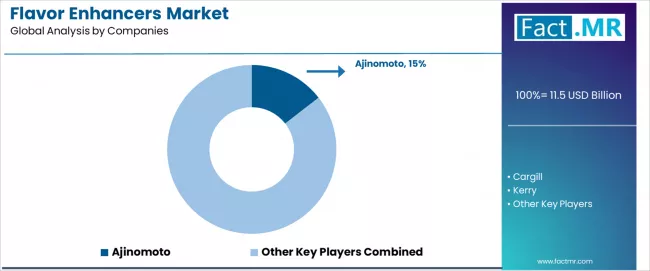
- Structure: ~15-20 credible players; top 3-5 hold ~55-60% by revenue.
- Leadership is maintained through: taste expertise, application support, and global distribution capabilities.
- What's commoditizing: basic MSG products and standard enhancement formulations.
- Margin Opportunities: natural alternatives, custom formulations, and application-specific solutions.
| Stakeholder | What they actually control | Typical strengths | Typical blind spots |
|---|---|---|---|
| Global flavor leaders | Technology platforms, application expertise, market reach | Comprehensive solutions, technical support, global presence | Local taste preferences; niche applications |
| Natural ingredient specialists | Clean label expertise, organic alternatives, premium positioning | Health positioning, natural credentials | Scale limitations; cost competitiveness |
| Regional food companies | Local relationships, cultural understanding, competitive pricing | Market proximity, taste adaptation | Innovation capacity; technical expertise |
| Application specialists | Category expertise, custom solutions, technical services | Specialized knowledge, tailored offerings | Limited scale; market dependence |
Key Players in the Flavor Enhancers Market
- Ajinomoto
- Cargill
- Kerry
- Givaudan
- Firmenich
- Symrise
- DSM-Firmenich
- Tate & Lyle
- Sensient
- Angel Yeast
Scope of the Report
| Item | Value |
|---|---|
| Quantitative Units | USD 11.5 billion |
| Type | MSG, Hydrolyzed Proteins, Nucleotides & Others |
| Application | Processed Foods, Beverages, Savory Snacks/Others |
| Form | Powder, Liquid |
| End Use | Convenience Foods, Restaurant Applications, Industrial Food Production, Specialty Culinary |
| Regions Covered | North America, Western Europe, East Asia, South Asia Pacific, Latin America, Middle East & Africa |
| Countries Covered | United States, Germany, United Kingdom, France, Japan, South Korea, Mexico, Canada, Italy, and 25+ additional countries |
| Key Companies Profiled | Ajinomoto, Cargill, Kerry, Givaudan, Firmenich, Symrise, DSM-Firmenich, Tate & Lyle, Sensient, Angel Yeast |
| Additional Attributes | Dollar sales by type and application categories, regional adoption trends across North America, Western Europe, and East Asia, competitive landscape with food technology manufacturers and ingredient suppliers, food processor preferences for taste optimization and cost efficiency, integration with food processing platforms and culinary systems, innovations in flavor enhancement technology and natural alternatives, and development of clean label solutions with enhanced performance and culinary optimization capabilities. |
Flavor Enhancers Market by Segments
-
Type:
- MSG
- Hydrolyzed Proteins
- Nucleotides & Others
-
Application:
- Processed Foods
- Beverages
- Savory Snacks/Others
-
Form:
- Powder
- Liquid
-
End Use:
- Convenience Foods
- Restaurant Applications
- Industrial Food Production
- Specialty Culinary
-
Region:
- North America
- United States
- Canada
- Mexico
- Western Europe
- Germany
- United Kingdom
- France
- Italy
- Spain
- Nordic
- BENELUX
- Rest of Western Europe
- East Asia
- China
- Japan
- South Korea
- South Asia Pacific
- India
- ASEAN
- Australia & New Zealand
- Rest of South Asia Pacific
- Latin America
- Brazil
- Chile
- Rest of Latin America
- Middle East & Africa
- Kingdom of Saudi Arabia
- Other GCC Countries
- Turkey
- South Africa
- Other African Union
- Rest of Middle East & Africa
- North America
Table of Content
- Executive Summary
- Global Market Outlook
- Demand to side Trends
- Supply to side Trends
- Technology Roadmap Analysis
- Analysis and Recommendations
- Market Overview
- Market Coverage / Taxonomy
- Market Definition / Scope / Limitations
- Market Background
- Market Dynamics
- Drivers
- Restraints
- Opportunity
- Trends
- Scenario Forecast
- Demand in Optimistic Scenario
- Demand in Likely Scenario
- Demand in Conservative Scenario
- Opportunity Map Analysis
- Product Life Cycle Analysis
- Supply Chain Analysis
- Investment Feasibility Matrix
- Value Chain Analysis
- PESTLE and Porter’s Analysis
- Regulatory Landscape
- Regional Parent Market Outlook
- Production and Consumption Statistics
- Import and Export Statistics
- Market Dynamics
- Global Market Analysis 2020 to 2024 and Forecast, 2025 to 2035
- Historical Market Size Value (USD Million) Analysis, 2020 to 2024
- Current and Future Market Size Value (USD Million) Projections, 2025 to 2035
- Y to o to Y Growth Trend Analysis
- Absolute $ Opportunity Analysis
- Global Market Pricing Analysis 2020 to 2024 and Forecast 2025 to 2035
- Global Market Analysis 2020 to 2024 and Forecast 2025 to 2035, By Type
- Introduction / Key Findings
- Historical Market Size Value (USD Million) Analysis By Type , 2020 to 2024
- Current and Future Market Size Value (USD Million) Analysis and Forecast By Type , 2025 to 2035
- MSG
- Hydrolyzed Proteins
- Nucleotides & Others
- Y to o to Y Growth Trend Analysis By Type , 2020 to 2024
- Absolute $ Opportunity Analysis By Type , 2025 to 2035
- Global Market Analysis 2020 to 2024 and Forecast 2025 to 2035, By Application
- Introduction / Key Findings
- Historical Market Size Value (USD Million) Analysis By Application, 2020 to 2024
- Current and Future Market Size Value (USD Million) Analysis and Forecast By Application, 2025 to 2035
- Processed Foods
- Beverages
- Savory Snacks/Others
- Y to o to Y Growth Trend Analysis By Application, 2020 to 2024
- Absolute $ Opportunity Analysis By Application, 2025 to 2035
- Global Market Analysis 2020 to 2024 and Forecast 2025 to 2035, By Region
- Introduction
- Historical Market Size Value (USD Million) Analysis By Region, 2020 to 2024
- Current Market Size Value (USD Million) Analysis and Forecast By Region, 2025 to 2035
- North America
- Latin America
- Western Europe
- Eastern Europe
- East Asia
- South Asia and Pacific
- Middle East & Africa
- Market Attractiveness Analysis By Region
- North America Market Analysis 2020 to 2024 and Forecast 2025 to 2035, By Country
- Historical Market Size Value (USD Million) Trend Analysis By Market Taxonomy, 2020 to 2024
- Market Size Value (USD Million) Forecast By Market Taxonomy, 2025 to 2035
- By Country
- USA
- Canada
- Mexico
- By Type
- By Application
- By Country
- Market Attractiveness Analysis
- By Country
- By Type
- By Application
- Key Takeaways
- Latin America Market Analysis 2020 to 2024 and Forecast 2025 to 2035, By Country
- Historical Market Size Value (USD Million) Trend Analysis By Market Taxonomy, 2020 to 2024
- Market Size Value (USD Million) Forecast By Market Taxonomy, 2025 to 2035
- By Country
- Brazil
- Chile
- Rest of Latin America
- By Type
- By Application
- By Country
- Market Attractiveness Analysis
- By Country
- By Type
- By Application
- Key Takeaways
- Western Europe Market Analysis 2020 to 2024 and Forecast 2025 to 2035, By Country
- Historical Market Size Value (USD Million) Trend Analysis By Market Taxonomy, 2020 to 2024
- Market Size Value (USD Million) Forecast By Market Taxonomy, 2025 to 2035
- By Country
- Germany
- UK
- Italy
- Spain
- France
- Nordic
- BENELUX
- Rest of Western Europe
- By Type
- By Application
- By Country
- Market Attractiveness Analysis
- By Country
- By Type
- By Application
- Key Takeaways
- Eastern Europe Market Analysis 2020 to 2024 and Forecast 2025 to 2035, By Country
- Historical Market Size Value (USD Million) Trend Analysis By Market Taxonomy, 2020 to 2024
- Market Size Value (USD Million) Forecast By Market Taxonomy, 2025 to 2035
- By Country
- Russia
- Poland
- Hungary
- Balkan & Baltic
- Rest of Eastern Europe
- By Type
- By Application
- By Country
- Market Attractiveness Analysis
- By Country
- By Type
- By Application
- Key Takeaways
- East Asia Market Analysis 2020 to 2024 and Forecast 2025 to 2035, By Country
- Historical Market Size Value (USD Million) Trend Analysis By Market Taxonomy, 2020 to 2024
- Market Size Value (USD Million) Forecast By Market Taxonomy, 2025 to 2035
- By Country
- China
- Japan
- South Korea
- By Type
- By Application
- By Country
- Market Attractiveness Analysis
- By Country
- By Type
- By Application
- Key Takeaways
- South Asia and Pacific Market Analysis 2020 to 2024 and Forecast 2025 to 2035, By Country
- Historical Market Size Value (USD Million) Trend Analysis By Market Taxonomy, 2020 to 2024
- Market Size Value (USD Million) Forecast By Market Taxonomy, 2025 to 2035
- By Country
- India
- ASEAN
- Australia & New Zealand
- Rest of South Asia and Pacific
- By Type
- By Application
- By Country
- Market Attractiveness Analysis
- By Country
- By Type
- By Application
- Key Takeaways
- Middle East & Africa Market Analysis 2020 to 2024 and Forecast 2025 to 2035, By Country
- Historical Market Size Value (USD Million) Trend Analysis By Market Taxonomy, 2020 to 2024
- Market Size Value (USD Million) Forecast By Market Taxonomy, 2025 to 2035
- By Country
- Kingdom of Saudi Arabia
- Other GCC Countries
- Turkiye
- South Africa
- Other African Union
- Rest of Middle East & Africa
- By Type
- By Application
- By Country
- Market Attractiveness Analysis
- By Country
- By Type
- By Application
- Key Takeaways
- Key Countries Market Analysis
- USA
- Pricing Analysis
- Market Share Analysis, 2024
- By Type
- By Application
- Canada
- Pricing Analysis
- Market Share Analysis, 2024
- By Type
- By Application
- Mexico
- Pricing Analysis
- Market Share Analysis, 2024
- By Type
- By Application
- Brazil
- Pricing Analysis
- Market Share Analysis, 2024
- By Type
- By Application
- Chile
- Pricing Analysis
- Market Share Analysis, 2024
- By Type
- By Application
- Germany
- Pricing Analysis
- Market Share Analysis, 2024
- By Type
- By Application
- UK
- Pricing Analysis
- Market Share Analysis, 2024
- By Type
- By Application
- Italy
- Pricing Analysis
- Market Share Analysis, 2024
- By Type
- By Application
- Spain
- Pricing Analysis
- Market Share Analysis, 2024
- By Type
- By Application
- France
- Pricing Analysis
- Market Share Analysis, 2024
- By Type
- By Application
- India
- Pricing Analysis
- Market Share Analysis, 2024
- By Type
- By Application
- ASEAN
- Pricing Analysis
- Market Share Analysis, 2024
- By Type
- By Application
- Australia & New Zealand
- Pricing Analysis
- Market Share Analysis, 2024
- By Type
- By Application
- China
- Pricing Analysis
- Market Share Analysis, 2024
- By Type
- By Application
- Japan
- Pricing Analysis
- Market Share Analysis, 2024
- By Type
- By Application
- South Korea
- Pricing Analysis
- Market Share Analysis, 2024
- By Type
- By Application
- Russia
- Pricing Analysis
- Market Share Analysis, 2024
- By Type
- By Application
- Poland
- Pricing Analysis
- Market Share Analysis, 2024
- By Type
- By Application
- Hungary
- Pricing Analysis
- Market Share Analysis, 2024
- By Type
- By Application
- Kingdom of Saudi Arabia
- Pricing Analysis
- Market Share Analysis, 2024
- By Type
- By Application
- Turkiye
- Pricing Analysis
- Market Share Analysis, 2024
- By Type
- By Application
- South Africa
- Pricing Analysis
- Market Share Analysis, 2024
- By Type
- By Application
- USA
- Market Structure Analysis
- Competition Dashboard
- Competition Benchmarking
- Market Share Analysis of Top Players
- By Regional
- By Type
- By Application
- Competition Analysis
- Competition Deep Dive
- Ajinomoto
- Overview
- Product Portfolio
- Profitability by Market Segments (Product/Age /Sales Channel/Region)
- Sales Footprint
- Strategy Overview
- Marketing Strategy
- Product Strategy
- Channel Strategy
- Cargill
- Kerry
- Givaudan
- Firmenich
- Symrise
- DSM-Firmenich
- Tate & Lyle
- Sensient
- Angel Yeast
- Ajinomoto
- Competition Deep Dive
- Assumptions & Acronyms Used
- Research Methodology
List Of Table
- Table 1: Global Market Value (USD Million) Forecast by Region, 2020 to 2035
- Table 2: Global Market Value (USD Million) Forecast by Type , 2020 to 2035
- Table 3: Global Market Value (USD Million) Forecast by Application, 2020 to 2035
- Table 4: North America Market Value (USD Million) Forecast by Country, 2020 to 2035
- Table 5: North America Market Value (USD Million) Forecast by Type , 2020 to 2035
- Table 6: North America Market Value (USD Million) Forecast by Application, 2020 to 2035
- Table 7: Latin America Market Value (USD Million) Forecast by Country, 2020 to 2035
- Table 8: Latin America Market Value (USD Million) Forecast by Type , 2020 to 2035
- Table 9: Latin America Market Value (USD Million) Forecast by Application, 2020 to 2035
- Table 10: Western Europe Market Value (USD Million) Forecast by Country, 2020 to 2035
- Table 11: Western Europe Market Value (USD Million) Forecast by Type , 2020 to 2035
- Table 12: Western Europe Market Value (USD Million) Forecast by Application, 2020 to 2035
- Table 13: Eastern Europe Market Value (USD Million) Forecast by Country, 2020 to 2035
- Table 14: Eastern Europe Market Value (USD Million) Forecast by Type , 2020 to 2035
- Table 15: Eastern Europe Market Value (USD Million) Forecast by Application, 2020 to 2035
- Table 16: East Asia Market Value (USD Million) Forecast by Country, 2020 to 2035
- Table 17: East Asia Market Value (USD Million) Forecast by Type , 2020 to 2035
- Table 18: East Asia Market Value (USD Million) Forecast by Application, 2020 to 2035
- Table 19: South Asia and Pacific Market Value (USD Million) Forecast by Country, 2020 to 2035
- Table 20: South Asia and Pacific Market Value (USD Million) Forecast by Type , 2020 to 2035
- Table 21: South Asia and Pacific Market Value (USD Million) Forecast by Application, 2020 to 2035
- Table 22: Middle East & Africa Market Value (USD Million) Forecast by Country, 2020 to 2035
- Table 23: Middle East & Africa Market Value (USD Million) Forecast by Type , 2020 to 2035
- Table 24: Middle East & Africa Market Value (USD Million) Forecast by Application, 2020 to 2035
List Of Figures
- Figure 1: Global Market Pricing Analysis
- Figure 2: Global Market Value (USD Million) Forecast 2020-2035
- Figure 3: Global Market Value Share and BPS Analysis by Type , 2025 and 2035
- Figure 4: Global Market Y to o to Y Growth Comparison by Type , 2025-2035
- Figure 5: Global Market Attractiveness Analysis by Type
- Figure 6: Global Market Value Share and BPS Analysis by Application, 2025 and 2035
- Figure 7: Global Market Y to o to Y Growth Comparison by Application, 2025-2035
- Figure 8: Global Market Attractiveness Analysis by Application
- Figure 9: Global Market Value (USD Million) Share and BPS Analysis by Region, 2025 and 2035
- Figure 10: Global Market Y to o to Y Growth Comparison by Region, 2025-2035
- Figure 11: Global Market Attractiveness Analysis by Region
- Figure 12: North America Market Incremental Dollar Opportunity, 2025-2035
- Figure 13: Latin America Market Incremental Dollar Opportunity, 2025-2035
- Figure 14: Western Europe Market Incremental Dollar Opportunity, 2025-2035
- Figure 15: Eastern Europe Market Incremental Dollar Opportunity, 2025-2035
- Figure 16: East Asia Market Incremental Dollar Opportunity, 2025-2035
- Figure 17: South Asia and Pacific Market Incremental Dollar Opportunity, 2025-2035
- Figure 18: Middle East & Africa Market Incremental Dollar Opportunity, 2025-2035
- Figure 19: North America Market Value Share and BPS Analysis by Country, 2025 and 2035
- Figure 20: North America Market Value Share and BPS Analysis by Type , 2025 and 2035
- Figure 21: North America Market Y to o to Y Growth Comparison by Type , 2025-2035
- Figure 22: North America Market Attractiveness Analysis by Type
- Figure 23: North America Market Value Share and BPS Analysis by Application, 2025 and 2035
- Figure 24: North America Market Y to o to Y Growth Comparison by Application, 2025-2035
- Figure 25: North America Market Attractiveness Analysis by Application
- Figure 26: Latin America Market Value Share and BPS Analysis by Country, 2025 and 2035
- Figure 27: Latin America Market Value Share and BPS Analysis by Type , 2025 and 2035
- Figure 28: Latin America Market Y to o to Y Growth Comparison by Type , 2025-2035
- Figure 29: Latin America Market Attractiveness Analysis by Type
- Figure 30: Latin America Market Value Share and BPS Analysis by Application, 2025 and 2035
- Figure 31: Latin America Market Y to o to Y Growth Comparison by Application, 2025-2035
- Figure 32: Latin America Market Attractiveness Analysis by Application
- Figure 33: Western Europe Market Value Share and BPS Analysis by Country, 2025 and 2035
- Figure 34: Western Europe Market Value Share and BPS Analysis by Type , 2025 and 2035
- Figure 35: Western Europe Market Y to o to Y Growth Comparison by Type , 2025-2035
- Figure 36: Western Europe Market Attractiveness Analysis by Type
- Figure 37: Western Europe Market Value Share and BPS Analysis by Application, 2025 and 2035
- Figure 38: Western Europe Market Y to o to Y Growth Comparison by Application, 2025-2035
- Figure 39: Western Europe Market Attractiveness Analysis by Application
- Figure 40: Eastern Europe Market Value Share and BPS Analysis by Country, 2025 and 2035
- Figure 41: Eastern Europe Market Value Share and BPS Analysis by Type , 2025 and 2035
- Figure 42: Eastern Europe Market Y to o to Y Growth Comparison by Type , 2025-2035
- Figure 43: Eastern Europe Market Attractiveness Analysis by Type
- Figure 44: Eastern Europe Market Value Share and BPS Analysis by Application, 2025 and 2035
- Figure 45: Eastern Europe Market Y to o to Y Growth Comparison by Application, 2025-2035
- Figure 46: Eastern Europe Market Attractiveness Analysis by Application
- Figure 47: East Asia Market Value Share and BPS Analysis by Country, 2025 and 2035
- Figure 48: East Asia Market Value Share and BPS Analysis by Type , 2025 and 2035
- Figure 49: East Asia Market Y to o to Y Growth Comparison by Type , 2025-2035
- Figure 50: East Asia Market Attractiveness Analysis by Type
- Figure 51: East Asia Market Value Share and BPS Analysis by Application, 2025 and 2035
- Figure 52: East Asia Market Y to o to Y Growth Comparison by Application, 2025-2035
- Figure 53: East Asia Market Attractiveness Analysis by Application
- Figure 54: South Asia and Pacific Market Value Share and BPS Analysis by Country, 2025 and 2035
- Figure 55: South Asia and Pacific Market Value Share and BPS Analysis by Type , 2025 and 2035
- Figure 56: South Asia and Pacific Market Y to o to Y Growth Comparison by Type , 2025-2035
- Figure 57: South Asia and Pacific Market Attractiveness Analysis by Type
- Figure 58: South Asia and Pacific Market Value Share and BPS Analysis by Application, 2025 and 2035
- Figure 59: South Asia and Pacific Market Y to o to Y Growth Comparison by Application, 2025-2035
- Figure 60: South Asia and Pacific Market Attractiveness Analysis by Application
- Figure 61: Middle East & Africa Market Value Share and BPS Analysis by Country, 2025 and 2035
- Figure 62: Middle East & Africa Market Value Share and BPS Analysis by Type , 2025 and 2035
- Figure 63: Middle East & Africa Market Y to o to Y Growth Comparison by Type , 2025-2035
- Figure 64: Middle East & Africa Market Attractiveness Analysis by Type
- Figure 65: Middle East & Africa Market Value Share and BPS Analysis by Application, 2025 and 2035
- Figure 66: Middle East & Africa Market Y to o to Y Growth Comparison by Application, 2025-2035
- Figure 67: Middle East & Africa Market Attractiveness Analysis by Application
- Figure 68: Global Market - Tier Structure Analysis
- Figure 69: Global Market - Company Share Analysis
- FAQs -
How big is the flavor enhancers market in 2025?
The global flavor enhancers market is estimated to be valued at USD 11.5 billion in 2025.
What will be the size of flavor enhancers market in 2035?
The market size for the flavor enhancers market is projected to reach USD 16.5 billion by 2035.
How much will be the flavor enhancers market growth between 2025 and 2035?
The flavor enhancers market is expected to grow at a 3.7% CAGR between 2025 and 2035.
What are the key product types in the flavor enhancers market?
The key product types in flavor enhancers market are msg, hydrolyzed proteins and nucleotides & others.
Which application segment to contribute significant share in the flavor enhancers market in 2025?
In terms of application, processed foods segment to command 48.0% share in the flavor enhancers market in 2025.